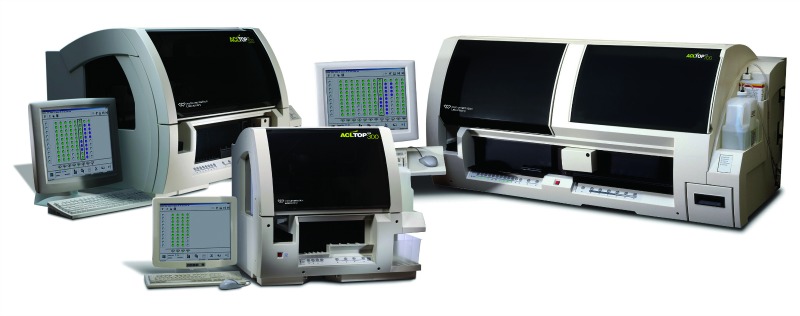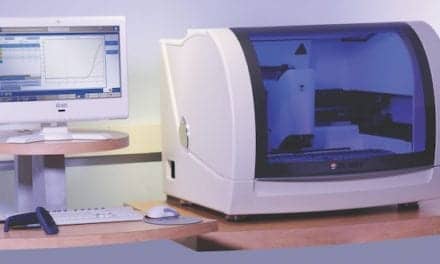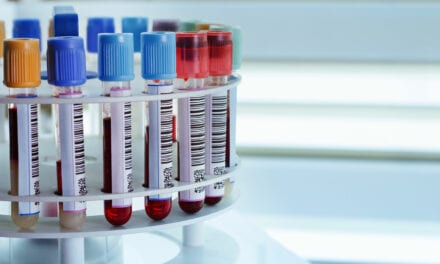In laboratory, bedside, and home settings, coagulation analyzers are vital for advanced patient care
By Karen Appold
Assessing and monitoring the coagulation status of patients is among the highest-risk areas of clinical lab testing. Even in the face of failing physiology or drug interferences, correctly measuring patients’ coagulation status is critical for a wide range of therapeutic interventions. Testing needs vary from cardiovascular diagnosis and perioperative assessment to daily home-use testing, and are matched by users with equally varied qualifications—including patients themselves. To meet the needs of this critical care market, manufacturers of coagulation analyzers design, develop, and market a variety of products matched to the intended users and their settings.
THE CHALLENGES
According to Neil S. Harris, MBChB, MD, FCAP, clinical associate professor of pathology, immunology, and laboratory medicine at the University of Florida College of Medicine, and director of the core laboratory at UF Health Pathology Laboratories, the most difficult challenges faced by clinicians involve special coagulation testing—particularly, factor assays. “A very stable calibration curve would be most helpful to have, as well as an analysis of the factor dilutions to tell us whether or not they are appropriately parallel,” he says.
The UF laboratory currently uses three analyzers that run all of its coagulation testing. “Generally, we do not distinguish between routine and special coagulation tests,” he explains. “We do use an auto-verification system, which is essential for basic coagulation testing such as partial thromboplastin time, prothrombin time, and fibrinogen.”
Jawed Fareed, PhD, professor of pathology and pharmacology at Loyola University, and director of the hemostasis and thrombosis research unit at Loyola University Medical Center, says the most difficult challenge is to find an instrument that is cost-effective and can also fulfill multiple needs—such as batch processing, high throughput, and discrete analysis (eg, stat samples).
Loyola’s medical center has core labs with automated high-throughput analyzers that perform coagulation testing for all inpatients and outpatients. Point-of-care (POC) testing with a quick turnaround time is available for pediatrics, the emergency department, clinics with satellite labs, and research labs. The center’s operating room has special instruments for thrombelastography and thromboelastometry.
Harris also finds it difficult to validate new oral anticoagulants such as dabigatran and rivaroxaban. “The issue here is the lack of clinical specimens for sample validation,” he explains. “These drugs are rarely measured except in cases of acute bleeding. Because of this, there is a scarcity of validation material—which is a Catch-22.”
David Pearman, global marketing manager for Helena Laboratories Corp, Beaumont, Tex, believes that some of the most difficult challenges in the field of coagulation testing are driven by the continued release of esoteric anticoagulants. “The pharmaceutical industry has a mission to develop drugs that do not have to be monitored,” he says. “However, after the release of a new molecule, real outcomes tend to leave the clinician asking the laboratory and diagnostic manufacturers for a solution.”
The growth of POC testing poses yet another challenge. POC coagulation assays frequently suffer from an inability to match laboratory assays. “While correlation or concordance is typically realized, end users cannot always understand the differences—even though guidelines from the College of American Pathologists, the Clinical Laboratory Improvement Advisory Committee, and other organizations provide specific instructions on how to deal with POC testing,” Pearman says.
Venita Shirley, MBA, MT(ASCP), North American marketing director for hemostasis at Instrumentation Laboratory, Bedford, Mass, believes that because some hemostasis labs have been unable to update their systems in more than 15 years, patient care could be negatively affected. Hindrances in such labs may include the influence of preanalytical variables; laborious, manual testing processes; and assays that are nonspecific.
“All of these limitations may negatively affect the quality or timely delivery of test results, and ultimately, the quality of patient care,” Shirley maintains.
Jackie Hauser, MT(ASCP), director of US hemostasis business management at Siemens Healthcare Diagnostics, Tarrytown, NY, says laboratorians need simple and dependable coagulation analyzers capable of producing fast, accurate, and reliable results. “Thus, challenges faced by labs tend to revolve around workflow efficiency and preanalytical sample integrity,” she says.
THE DREAM MACHINE
Features Harris would most like to see on the next generation of coagulation analyzers and monitors include an automated immunoassay for heparin-platelet factor IV antibodies as well as for anti-phospholipid antibodies (anti-cardiolipin and anti-beta 2 glycoprotein 1). A quantitative factor XIII assay would also be extremely helpful.
Fareed would like to see a method to determine coagulation factors more quickly—without having to go through all of the different curves—for different problems such as hemophilia, anti-phospholipid antibodies, and other factor deficiencies. He’d also like to have the ability to further analyze coagulation factors and identify problems such as disseminated intravascular coagulation and anti-phospholipid antibodies. Having the capability to monitor new anticoagulants is also on his ideal list.
In the next generation of coagulation analyzers and monitors, Fareed would like to see an instrument that can perform platelet and clotting studies simultaneously. “We would like to have an instrument that could analyze whole blood and plasma clotting, fibrinolytic parameters, platelet function studies, and biomarkers of hemostatic dysfunction in one instrument—that would be the dream,” he says, adding that it should offer rapid turnaround time as well.
A SAMPLING OF OFFERINGS
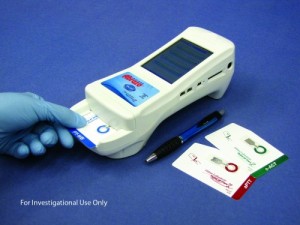
In the first phase of its global launch, Helena Laboratories has received CE marking for its new Cascade Abrazo.
For the past 3 years, Helena Laboratories has been working to satisfy FDA requirements in order to launch its newest analyzer, the Abrazo. “While it is actually a next-generation version of our Cascade POC analyzer, it offers numerous improvements through onboard technology to support data management, connectivity, user interface, and so on,” says Pearman. “In 3 years we expect to have at least 12 POC coagulation assays in a single instrument, which will be a first for POC coagulation testing.”
Other features that make the product especially suited for today’s market segment include a color touch screen, personal computer-based software engine, wireless capabilities, secure digital card slot, RS-232 and USB ports, small size and ergonomic lightweight design, lithium rechargeable batteries, and numerous assays on a single standardized platform.
Regarding pre-existing analyzers and monitors, Helena Laboratories has made numerous improvements to platelet aggregation software that have been a direct result of end user input. Such changes responded directly to the company’s mission to focus on customer needs.
Siemens and Sysmex Corp, Kobe, Japan, maintain a long-standing global partnership for the development and distribution of hemostasis instruments and reagents. In the past several years, Siemens has released coagulation analyzers outside of the United States to help address challenges. Specifically, in 2012, Siemens released the Sysmex CS-5100 system, which uses preanalytical sample integrity (PSI) technology to automate and standardize sample management, detecting unsuitable samples prior to analysis. The instrument is targeted to high-volume coagulation laboratories. Earlier, in 2009, Siemens launched the Sysmex CS-2000i and CS-2100i analyzers (not available in the United States), which provide that same PSI technology for mid-volume laboratories.
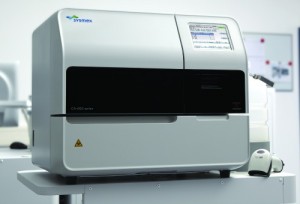
Sysmex CA-600 series systems are capable of performing as both stand-alone systems in lower-volume laboratories as well as powerful backup analyzers in higher-volume lab settings.
Also in 2012, Siemens released the Sysmex CA-600 series systems in the United States. “These new models were designed to provide compact, fully automated hemostasis testing for low-volume laboratories,” says Hauser. The small footprint of the CA-600 coagulation analyzers allows low-volume labs, which typically process fewer than 50 samples a day, to maximize space while providing accurate results. The Sysmex CA-620 is specifically designed for labs conducting basic clotting tests, whereas the Sysmex CA-660 analyzer offers additional chromogenic and immunoassay testing. The CA-600 systems are capable of performing as both stand-alone systems in lower-volume laboratories as well as powerful backup analyzers in higher-volume lab settings.
Instrumentation Laboratory offers the ACL Top family of hemostasis testing systems, which includes five models that all use the same operating system, reagents, and consumables. According to Shirley, such a family approach provides a true standardized solution for integrated health networks, and helps large-volume labs improve efficiencies. The ACL Top 700 series automates manual tasks, freeing up staff to focus on other critical activities. The ACL Top 500 CTS and ACL Top 300 CTS systems expand lab capacity and test menus, while minimizing test send-outs and associated lost revenues. In addition, they enable medium- and small-volume labs to do more with less.
New assays enable Instrumentation Laboratory’s customers to provide better testing results and on-demand testing. For example, the company’s HemosIL D-Dimer HS 500 assay demonstrates higher specificity than other D-Dimer assays and is cleared for the exclusion of deep vein thrombosis and pulmonary embolism, when used in conjunction with a clinical PTP score. “This reduces unnecessary imaging and potentially enhances patient care,” Shirley says.
To further improve efficiencies in the lab, the company will be introducing a liquid ready-to-use prothrombin time reagent that features robust stability, decreasing reagent prep time.
MARKET TRENDS
Looking ahead, Helena Laboratories’ business plan is focused on electrophoresis, platelet aggregation, and POC testing (mostly hemostasis), while still supporting a small amount of manual and semiautomated coagulation business. “It is very difficult to compete with the large coagulation manufacturers, and therefore our business model reflects the items we do best,” says Pearman.
While Helena Laboratories’ target market has tightened, POC coagulation testing continues to grow rapidly in the United States and especially in the company’s global markets, particularly for activated clotting time testing.
Siemens offers a variety of coagulation analyzers for all market segments, from compact systems for low-volume labs to analyzers with connectivity options and automation for high-volume labs. The breadth of the company’s portfolio is designed to most aptly meet the needs unique to these different market segments.
Overall, Hauser says, the market has become more consolidated, as more customers join organizations such as integrated delivery networks. This trend has resulted in more emphasis being placed on standardizing vendors for delivery of coagulation testing. In such a changing market, customers will look to vendors that can deliver solutions that reliably meet the needs of all of their different members.
“We have also seen a relatively recent trend where hospitals are setting up freestanding emergency rooms,” Hauser says. In these situations, we find that customers are seeking coagulation analyzers that are compact, reliable, and accurate.”
Shirley says that hospital laboratories are increasingly being asked to do more with less. “Our hemostasis systems and assays help improve lab efficiencies and contribute to controlling costs, not just in the lab but throughout the hospital,” she says.
FINAL THOUGHTS
A variety of challenges—such as validating new oral anticoagulants and having an instrument that can fulfill multiple needs—face clinicians and laboratorians who perform coagulation testing. In addition, instrumentation that can meet simple requirements such as speed, accuracy, and reliability is still sought-after. Manufacturers continue to address these challenges with new products and enhancements of existing products. While advances are being made, clinicians and laboratorians say there is still room for improvement.
Karen Appold is a contributing writer for CLP. For further information, contact chief editor Steve Halasey via [email protected].






